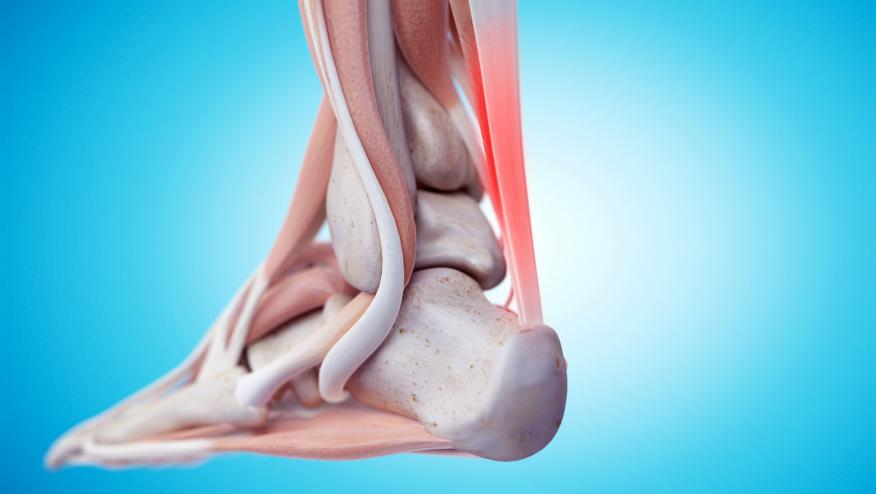Steroid Injection for Chronic Achilles Tendinopathy Save

Adding a corticosteroid shot to exercise therapy significantly improved symptoms of chronic Achilles tendinopathy, a 100-person randomized trial found.
At 6 months, mean improvement from baseline on the Victorian Institute of Sports Assessment-Achilles (VISA-A) scale was a significant and "clinically relevant" 17.7 points (95% CI 8.4-27.0) greater among patients receiving up to three ultrasound-guided corticosteroid injections versus those receiving placebo (P<0.001), according to Finn Johannsen, MD, of Bispebjerg Hospital in Copenhagen, and colleagues.
Both groups participated in established resistance exercise therapy and reported improvements over the 2 years of follow-up on the 100-point scale -- where the highest score indicates no symptoms. But patients in the corticosteroid group had significantly greater improvements at nearly all time points examined (except at 1 year).
"Importantly, we did not observe any detrimental effect of corticosteroid on clinical outcomes in the later phase (12-24 months after treatment start)," Johannsen's group wrote in JAMA Network Open. "These findings suggest that corticosteroid injection is effective when combined with exercise therapy in patients with long-standing AT [Achilles tendinopathy] and without major adverse events."
While both exercise therapy and corticosteroid injections are common approaches to treating chronic Achilles tendon pain and swelling, the evidence for the two in combination had been limited, they noted.
Patients' had established tendinopathy that averaged 20 months or longer. They were advised to refrain from running and jumping during the first 3 months of the study (99% complied), and the researchers suggested that this may have played an important role in the positive findings.
Secondary outcomes -- including morning pain on the 100-mm Visual Analog Scale (VAS) and tendon thickness -- favored the corticosteroid group at certain time points as well.
Johannsen and colleagues cautioned that the findings "may not necessarily apply to all tendons since corticosteroid injection has not provided an additive effect to exercises for shoulder pain or lateral epicondylitis, whereas it has been suggested to have an additive effect in plantar fasciitis."
From 2016 to 2018, the trial enrolled 100 consecutive adults up to age 65 (mean 46, 62% men) from a rheumatology clinic and university medical clinic in Denmark. Patients had to have Achilles tendon pain lasting more than 3 months, which was verified by ultrasound.
They were were randomized to exercise therapy (slow resistance program, three times per week) plus a corticosteroid or placebo injection. Patients were allowed to receive a second and third shot, each at least 4 weeks apart, so long as pain reached certain thresholds. In the corticosteroid group (n=48), 25% had three shots, 38% received two, and 31% only the one. In the placebo group (n=52), two-thirds received all three injections, 19% had two, and 6% received just the one.
At baseline, the two groups were similar in terms of average height (5' 10"), weight (174 lbs), Achilles tendon thickness (8.6-8.8 mm), morning pain (VAS score of 40-41), and pain during activity (VAS 45-48). Symptom duration was an average 26 months in the corticosteroid group and 20 months in the placebo group, and about 30% of patients in each group had bilateral injuries.
Inclusion criteria were as follows: chronic Achilles tendon pain that was worse in the morning and made worse by weight-bearing activity; pain and swelling at 2-6 cm from the Achilles tendon insertion point; and ultrasonography imaging showing thickening 7 mm greater (or more than 20% larger) than the asymptomatic side.
Patients, physicians, and assessors were blinded to the injection received.
Improvement in VISA-A score at 6 months was the primary endpoint, but assessments were performed at 1, 2, and 3 months, and at 1 and 2 years as well.
Mean VISA-A score at baseline was 43 in the corticosteroid group, which improved to 82 at 6 months before dipping to 76 at 1 year and landing at 86 for the final 2-year follow-up. In the placebo group, mean scores started at a slightly higher 50, before improving to 72 at 6 months, 79 at 1 year, and to 82 at 2 years.
For secondary endpoints, Achilles tendon thickness on ultrasound improved more in the corticosteroid group at 1, 2, 3, and 6 months (mean differences of 1.9 to 2.2 mm, P<0.001 for all). For pain on VAS, morning pain significantly improved at 2 months in the corticosteroid group, but no significant differences were seen at any time for pain during activity.
A limitation of the trial, noted the study authors, is that a psychometric analysis has recently questioned the validity and construct of the VISA-A, the most commonly used patient-reported outcome measure for trials in Achilles tendinopathy.









If you are a health practitioner, you may Login/Register to comment.
Due to the nature of these comment forums, only health practitioners are allowed to comment at this time.